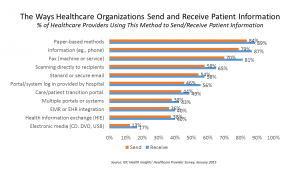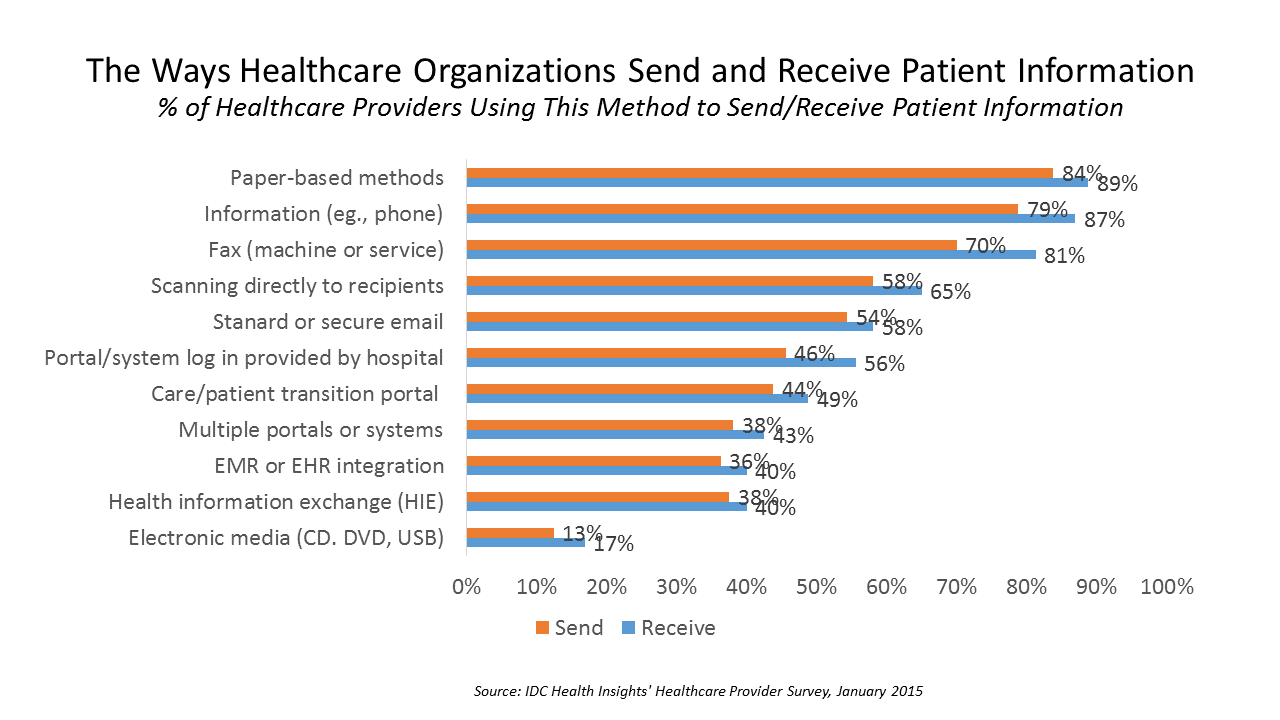
Faxing in health care ranks higher in patient data information sharing than using secure email, online portals, health information exchange (HIE), or leveraging electronic health records.
Welcome to the American healthcare system in 2016, as described in a market spotlight published by IDC, The Rocky Road to Information Sharing in the Health System.
IDC’s survey research among healthcare providers forecasts the “rocky road” to information sharing. That rocky road is built for medical errors, duplication of services, greater healthcare costs, and continued health il-literacy for many patients.
“The holy grail of interoperability — lower-cost, better-quality care with an improved experience for the patient facilitated by the secure exchange of information about participants in the health system — is still elusive for most providers,” IDC recognizes on page 1 of the paper.
Short-term costs savings may be found via paper-based methods like copy and fax, but not jumping to the second curve of digital health data exchange sacrifices security, quality, and risk — especially risk that might be assumed is new contracting and payment regimes like value-based care, bundling, and pay-for-performance. That’s because you [healthcare providers] can’t manage what you don’t measure.
The bar chart illustrates that the most prominent methods for sending and receiving patient information are paper-based methods, used by 9 in 10 providers to receive and 8 in 10 to receive that information; informal methods like phone calls, used by about 8 in 10 providers to send or receive; and that never-to-disappear fax machine used by 81% to receive and 70% to send patient information.
The HITECH Act’s incentives for adopting and fully implementing electronic health records (EHRs) don’t seem to have made a big difference in patient information data sharing. Only some 40% of healthcare providers are sending or receiving patient data via EMR/EHR integration, roughly the same as are using health information exchange (another HITECH Act artifact, still not hitting the tipping point of use).
The most important consequences of this current scenario are loss of business, decreased operational efficiency, billing and medical coding errors, and — worst of all — medical errors, IDC notes from healthcare providers’ input.
Health Populi’s Hot Points: Patients in the U.S. increasingly see the presence of EHRs in their clinicians’ offices and hospitals. But the presence of an EHR is no guarantee that the patient’s personal health information is secure or digitized in ways that promote high quality, efficient care and as well as manage the risk of medical errors.
The most recent Digital Health Funding Rankings report from Startup Health published that a record (high) of $1.88 bn in funding for digital health startups was invested in the first quarter of 2016. One-fifth of that money (about $400 mm) went to Oscar Health, the new-new health insurance plan which is expanding from New York to California, Texas and beyond. That leaves some $1.4 bn for startups dealing with big data/analytics, personalized health, behavioral and mental health, wellness, and clinical decision support. In addition, deals involving “patient/consumer experience” garnered $195 mm.
What fell into patient/consumer experience in this first quarter of 2016 included $95 mm going to Healthline, the online consumer health information portal, and $40 mm to Higi, the retail health kiosk company, among smaller deals in the segment.
There are a lot of sexy new areas of digital health investment here – Oscar has serious plans to disrupt health insurance as we know it, Flatiron Health and Health Catalyst will drive data analytics to support population health, and wellness companies may attract consumer and employer dollars to promote self-health. But only one of the big investments, in Captricity, deals with the kind of workflow we’re talking about when it comes to battling the monster that is paper in the healthcare system.
To this health economist who abhors wasting money and time, and hates medical errors, the real sexy investments will be in getting faxing relegated to the healthcare tech graveyard where it belongs.





 Thank you FeedSpot for
Thank you FeedSpot for